Jaisalmer travel - India, Asia
Jaisalmer, often referred to as the "Golden City," is located in the westernmost part of Rajasthan, India, amidst the vast Thar Desert. Jaisalmer is renowned for its stunning yellow sandstone architecture, which gives the city its golden hue, particularly visible in landmarks like the Jaisalmer Fort (Sonar Qila). This fort is not only a UNESCO World Heritage site but also a living fort, housing shops, hotels, and residences. The city is unique for its intricate havelis, such as Patwon Ki Haveli, and its vibrant desert culture, including traditional music and dance. Visitors are attracted to Jaisalmer for its breathtaking desert landscapes, camel safaris, and the annual Desert Festival, which showcases local arts and crafts. The city's blend of history, culture, and natural beauty makes it a captivating destination for travelers.
Population: Estimate 80,000 people (as of 2024)
Economy: Primarily driven by tourism, which has seen significant growth in recent years due to its unique desert landscape and rich cultural heritage. The tourism sector not only attracts domestic visitors but also a substantial number of international tourists, contributing significantly to local revenue.
The city also famous for its intricate handicrafts, including embroidered textiles, leather goods, and traditional jewelry.
Landmarks: Jaisalmer Fort, Patwon Ki Haveli, Salim Singh Ki Haveli, Nathmal Ki Haveli, Gadisar Lake, Thar Heritage Museum, Desert National Park
India
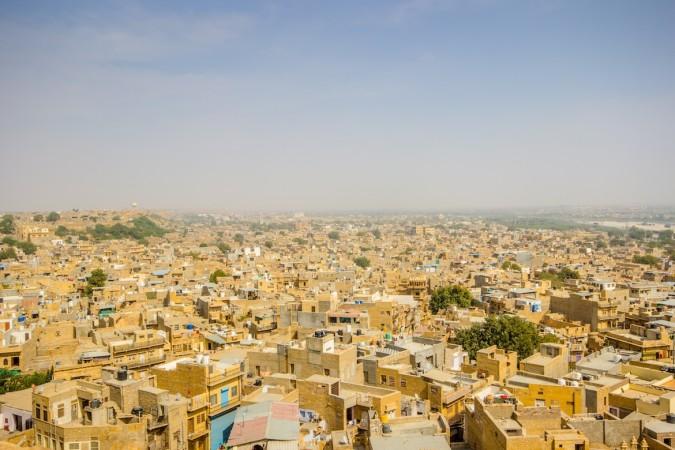
Overview of Jaisalmer
History & Cultural Influence
Bikaner, founded in 1488 by Rao Bika, is a historic city located in the northwestern state of Rajasthan, India, amidst the arid landscape of the Thar Desert. Its strategic position along ancient trade routes contributed to its prosperity, making it a cultural and economic hub. The city is renowned for its architectural marvels, particularly the Junagarh Fort, which has never been conquered, and the Lalgarh Palace, showcasing a blend of Rajput, Mughal, and European styles. Bikaner's cultural significance is further highlighted by its vibrant festivals, such as the Camel Festival, and its unique culinary offerings, including the famous Bikaneri Bhujia, making it a captivating destination for travelers interested in history, culture, and local traditions.
Interaction with The Locals
When interacting with locals in Jaisalmer, visitors can expect a warm and hospitable atmosphere. The population of Jaisalmer predominantly consisting of ethnic groups such as Rajputs, Baniyas, and various other communities, contributing to the city’s rich cultural tapestry.
The general attitude towards tourists is positive, as locals are often eager to share their heritage and traditions. English is widely spoken in tourist areas, making communication relatively easy, though it may be less common among older or rural residents. You should be mindful of local customs, such as greeting with "Namaste," dressing modestly, and respecting religious practices, which enhances interactions with the community.
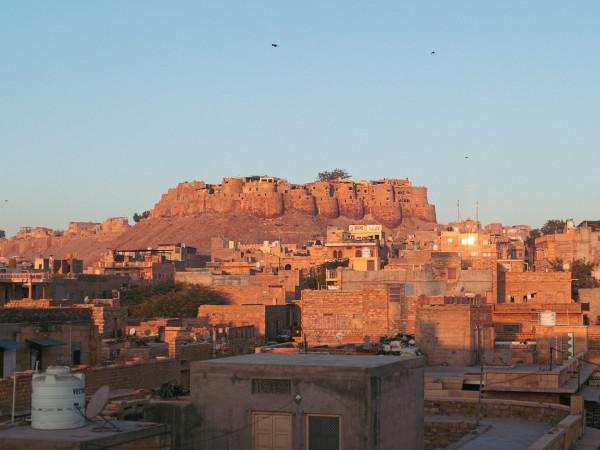
Jaisalmer Fort - © gather
Top attractions in Jaisalmer
Jaisalmer is home to the stunning Jaisalmer Fort, a UNESCO World Heritage Site that rises majestically from the desert landscape. The city's intricate Patwon Ki Haveli showcases exquisite architecture and craftsmanship, offering a glimpse into the opulent lifestyle of the merchants who once lived there. Don’t miss the Sam Sand Dunes, where you can experience the beauty of the Thar Desert through camel rides and enjoy mesmerizing sunset views.
Jaisalmer Fort
Location: Fort Road, Near Gopa Chowk, Jaisalmer
Jaisalmer Fort, also known as Sonar Quila or the Golden Fort, is a UNESCO World Heritage site and one of the largest living forts in the world. Built in 1156 AD, its yellow sandstone walls glow like gold in the sunlight, creating a mesmerizing sight. Within the fort, you'll find a vibrant community with shops, hotels, palaces, and temples, offering a unique blend of history and living culture as you explore its narrow lanes.
Patwon Ki Haveli
Location: Near Jaisalmer Fort, Jaisalmer
Patwon Ki Haveli, a stunning collection of five havelis built by a wealthy merchant in the 19th century, stands as a testament to Jaisalmer’s architectural brilliance. Known for its intricate carvings and elaborate facade, this haveli also houses a museum that provides insights into the rich history and culture of the region, making it a must-visit for those fascinated by the opulence of the past.
Gadisar Lake
Location: 2 km from Jaisalmer
Gadisar Lake, an artificial reservoir created in the 14th century, offers a serene escape surrounded by temples and ghats. This peaceful spot is perfect for a leisurely boat ride, especially at sunset when the golden light reflects off the water, creating a picture-perfect scene. Beyond its beauty, the lake holds cultural significance as a vital water source for the region.
Sam Sand Dunes
Location: 40 km from Jaisalmer
Sam Sand Dunes are the gateway to experiencing the Thar Desert's vast, rolling landscapes. Known for its stunning sunsets, this popular destination offers thrilling camel safaris, cultural performances, and desert camping under the starry sky. Whether you're seeking adventure or tranquility, the dunes provide a quintessential desert experience.
Jain Temples
Location: Inside Jaisalmer Fort
The Jain Temples within Jaisalmer Fort are a collection of beautifully carved shrines dedicated to various Jain Tirthankaras, dating from the 12th to 15th centuries. These temples, with their intricate marble and sandstone carvings, are not only a marvel of architecture but also hold deep spiritual significance. Exploring these temples offers a journey into the artistic and religious heritage of the region.
Kuldhara Abandoned Village
Location: 18 km west of Jaisalmer
Kuldhara, an abandoned village steeped in mystery, dates back to the 13th century and is shrouded in legend. Once a thriving community, it was suddenly deserted overnight, leaving behind an eerie but captivating atmosphere. Walking through its ruins, you'll be intrigued by the stories of its past, making it a fascinating site for history enthusiasts.
Desert National Park
Location: 45 km from Jaisalmer
Desert National Park, one of India's largest national parks covers an area of 3162 km², showcases the unique ecosystem of the Thar Desert. Home to a variety of wildlife, including the critically endangered Great Indian Bustard, the park is a haven for nature lovers. Visitors can embark on wildlife safaris, enjoy birdwatching, and soak in the stunning desert landscape, making it a perfect spot for adventure and exploration.
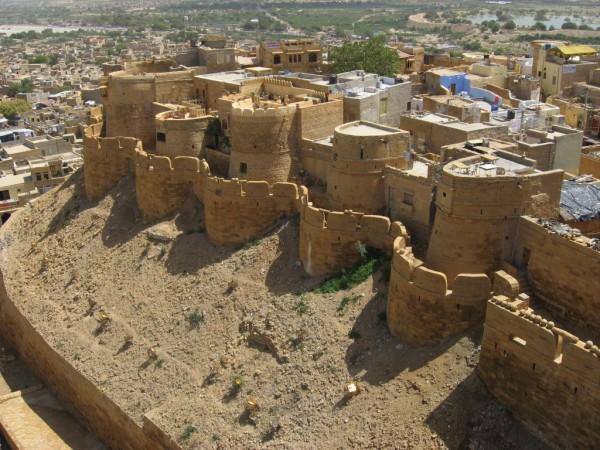
Patwon Ki Haveli - © gather
Must-Try Dishes in Jaisalmer
In Jaisalmer, your culinary journey isn't complete without trying Ker Sangri, a traditional Rajasthani dish made from dried desert beans and berries, cooked with local spices, offering a unique and flavorful taste of the region. Don’t miss Dal Baati Churma, a quintessential Rajasthani meal renowned for its rich flavor and melt-in-your-mouth texture.
Dal Baati Churma
Dal Baati Churma is a signature Rajasthani dish where baked wheat rolls (baati) are served with spicy lentil curry (dal) and a sweet crushed wheat dessert (churma). The baatis, often drenched in ghee, offer a rich and hearty flavor, making this dish a staple at local feasts and a true representation of Rajasthan’s culinary heritage.
Ker Sangri
Ker Sangri is a unique local specialty made from dried ker berries and sangri beans, cooked with an aromatic blend of spices like red chili and cumin. This dish embodies the resourcefulness of Rajasthani cuisine, utilizing ingredients that thrive in the desert landscape. Typically served with rotis, it offers a taste of the region's traditional flavors.
Ghotua Ladoo
Ghotua Ladoo is a beloved sweet treat made from roasted gram flour, sugar, and ghee, shaped into delicious, melt-in-your-mouth balls. Rich in flavor and often enjoyed during festivals, this dessert highlights the local craftsmanship in creating traditional sweets that are deeply rooted in Jaisalmer’s culture.
Kadi Pakora
Kadi Pakora is a tangy, comforting dish featuring gram flour fritters (pakoras) simmered in a spiced yogurt-based gravy. Typically served with rice or roti, it showcases the Rajasthani love for rich and flavorful dishes, making it a must-try for those seeking an authentic taste of local cuisine.
Bhang Lassi
Bhang Lassi is a traditional yogurt-based beverage infused with bhang (cannabis), along with milk, spices, and sweeteners. Known for its mild psychoactive effects, it’s a popular drink during festivals like Holi. While unique, it’s important to enjoy it responsibly, as it offers a glimpse into the cultural practices of the region.
Rajasthani Thali
A Rajasthani Thali is a grand feast, featuring a variety of regional dishes like dal, baati, churma, ker sangri, gatte ki sabzi, along with an assortment of breads and pickles. This elaborate meal is a must-try for anyone looking to experience the diverse and rich flavors of Rajasthani cuisine in one indulgent sitting.
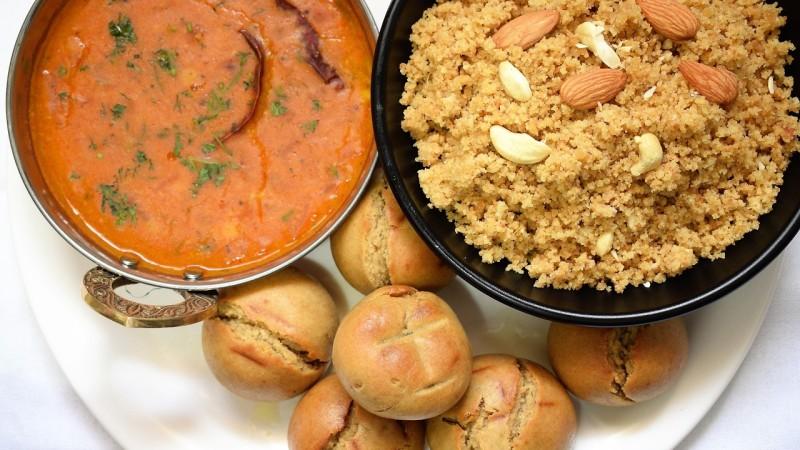
Dal Baati Churma - © gather
Festivals & Local Celebrations
Jaisalmer Desert Festival
Time of Year: February (typically the last week)
The Jaisalmer Desert Festival, or Maru Mahotsav, is a dazzling showcase of Rajasthani culture held against the breathtaking Thar Desert backdrop. This three-day festival is filled with excitement, featuring camel races, lively folk music and dance performances, turban-tying contests, and even a camel beauty pageant. As you immerse yourself in the vibrant atmosphere, you can savor traditional Rajasthani cuisine, shop for local handicrafts, and experience the colorful spirit of Jaisalmer at its best.
International Yoga Festival
Time of Year: January
Each January, Jaisalmer hosts the International Yoga Festival, drawing yoga enthusiasts from around the globe. Over three days, participants can engage in yoga sessions led by expert instructors, join meditation workshops, and enjoy cultural performances that highlight the region’s rich heritage. Set in the tranquil desert environment, this festival offers a perfect blend of spiritual growth and cultural immersion, making it a rejuvenating retreat.
Gangaur Festival
Time of Year: March-April (during the month of Chaitra)
Gangaur is a vibrant celebration in honor of Goddess Gauri, symbolizing marital bliss and prosperity. In Jaisalmer, the festival comes to life with colorful processions, traditional folk dances, and the beautifully decorated clay idols. As a visitor, you can witness women adorned in traditional attire, participating in singing and dancing, as the entire city is enveloped in festive cheer.
Teej Festival
Time of Year: July-August (during the month of Shravan)
The Teej Festival marks the joyous arrival of the monsoon season and is celebrated with great enthusiasm in Jaisalmer. The city comes alive with singing, dancing, and the beautifully decorated swings (jhoolas) in gardens. Women don colorful traditional outfits and take part in cultural festivities, offering a unique opportunity for visitors to experience the lively customs and traditions of Jaisalmer.
Diwali
Time of Year: October-November (date varies based on the lunar calendar)
Diwali, the Festival of Lights, is celebrated with unparalleled enthusiasm in Jaisalmer. The city sparkles with lights and decorations, as locals perform rituals to honor Goddess Lakshmi. Visitors can immerse themselves in the festive spirit, partake in local celebrations, and marvel at the spectacular fireworks that light up the desert sky, creating a truly magical and unforgettable experience.
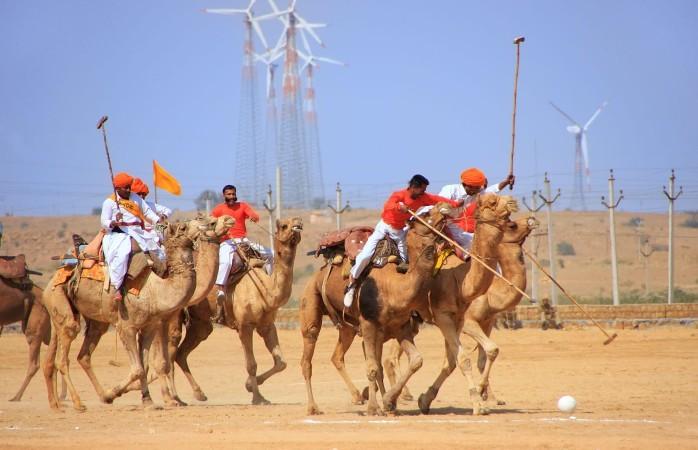
Jaisalmer Desert Festival - © gather
Weather in Jaisalmer: Best Time to Visit
Jaisalmer experiences an arid desert climate characterized by extreme temperatures and minimal rainfall.
Average Temperatures
- Summer (April to June): Temperatures can soar, often exceeding 45°C (113°F), particularly in May, with average highs around 41-43°C (106-109°F). Nights remain warm, averaging 26-30°C (79-86°F).
- Monsoon (July to September): This season brings some relief, with average temperatures ranging from 25°C (77°F) to 38°C (100°F). July and August receive the most rainfall, averaging 60-70 mm (2.4-2.8 inches).
- Winter (November to February): Winters are cooler, with daytime highs between 18°C (64°F) and 30°C (86°F) and nighttime lows dropping to around 5-10°C (41-50°F), especially in January, the coldest month.
Rainfall
Annual Rainfall: Jaisalmer receives about 200 mm (7.9 inches) of rain annually, primarily during the monsoon months from July to September.
Best Time to Travel
The best time to visit Jaisalmer is from mid-November to mid-February, when the weather is cooler and more comfortable for outdoor activities and sightseeing.
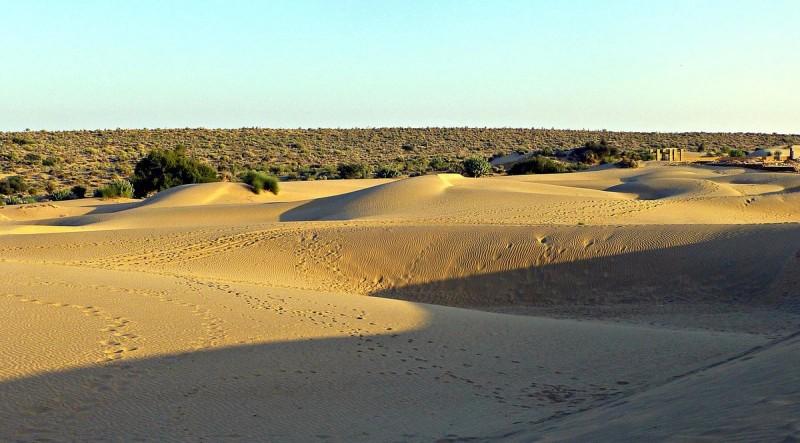
Desert National Park - © gather
Culture Etiquette in Jaisalmer
Dress Modestly
Jaisalmer is a conservative city, so dressing modestly is essential, especially when visiting religious sites. Women should cover their shoulders and knees, opting for loose-fitting clothing made from breathable fabrics suitable for the hot climate. Men are also encouraged to wear long pants and shirts.
Greetings
A polite greeting is always appreciated. Use "Namaste" or "Namaskar" while folding your hands in front of your chest as a sign of respect. Addressing people with titles such as "ji" (a term of respect) is also common.
Remove Shoes
It is customary to remove shoes before entering temples, mosques, and some havelis. Look for designated areas to leave your footwear, as this is a sign of respect for the sacred spaces.
Photography Etiquette
While photography is generally allowed, it is courteous to ask for permission before taking photos of people, especially women and religious figures. This shows respect for their privacy and cultural norms.
Bargaining
Bargaining is expected in local markets and with street vendors. Approach negotiations with politeness and respect, as this is a part of the shopping culture in Jaisalmer.
Respect Religious Practices
When visiting religious sites, maintain a respectful demeanor. Keep noise levels down, dress appropriately, and avoid taking photos unless permitted. Public displays of affection are not common and should be avoided.
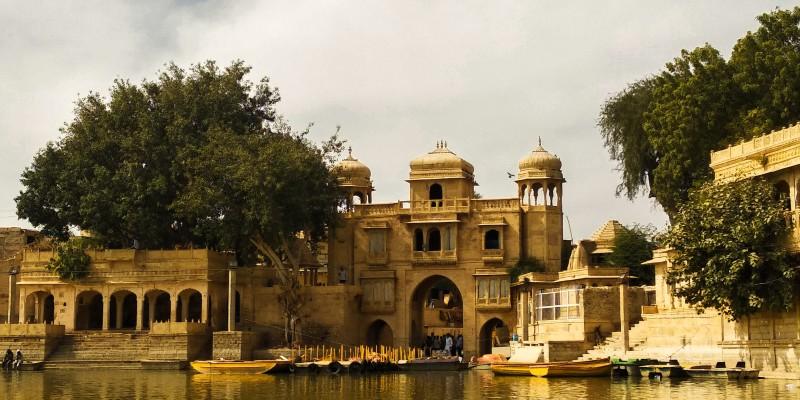
Gadisar Lake - © gather
Essential Travel Information
Getting to Jaisalmer
By Air
Jaisalmer has its own airport, Jaisalmer Airport, which opened in 2017. It offers direct flights primarily from Delhi, making air travel a quick option for visitors. The airport is about 5 km from the city center, and taxi services are readily available for transfers, typically starting at around ₹500 for a sedan .
By Train
Jaisalmer Railway Station is well-connected to major cities in India, including Delhi, Mumbai, and Ahmedabad. Trains such as the Runicha Express provide convenient access, with travel times from Delhi taking approximately 19 hours. The station is located close to the city center, making it easy for travelers to reach their accommodations.
By Road
Jaisalmer is accessible by road from major cities in Rajasthan. Regular bus services operate from cities like Jodhpur (about 5 hours away) and Jaipur (approximately 9-10 hours). Private taxis and self-drive options are also available for those who prefer flexibility in their travel plans.
Getting Around Jaisalmer
Auto Rickshaws
Auto rickshaws are a popular mode of transportation within Jaisalmer. They are readily available and are a convenient way to navigate the city, especially for short distances. It’s advisable to negotiate fares before starting your journey.
Taxis and Local Cabs
Local taxi services are available for city tours and excursions to nearby attractions. Many hotels can arrange taxis for guests, and it’s recommended to book in advance for convenience.
Motorcycle Rentals
For those looking for adventure, renting a motorcycle or scooter is an option. This allows travelers to explore the city and surrounding areas at their own pace, but caution is advised due to local traffic conditions.
Ride-Sharing Services
While traditional ride-sharing services like Uber are not widely available in Jaisalmer, local taxi services can often provide similar convenience.
ATM and Banking Services
Jaisalmer has several ATMs and banking facilities that provide easy access to cash:
Bank of India ATM
- Location: House No.1157, Dhibba Para, Jaisalmer
- Hours: Open 24 hours
Bank of Maharashtra ATM
- Location: No 659, Gandhi Colony, Nizam Colony, Jaisalmer
- Hours: Open 24 hours
HDFC Bank ATM
- Location: Ground Floor, Shiv Rd, Dhibba Para, Jaisalmer
- Hours: 8 AM – 8 PM
State Bank of India ATM
- Location: NH-15, Jaisalmer
- Hours: Open 24 hours
Accommodation Choices
Jaisalmer offers a variety of accommodation options catering to different budgets:
Luxury Hotels
- Suryagarh: A luxurious heritage hotel that blends traditional architecture with modern amenities, offering exquisite dining and spa services.
- Gorakh Haveli: A beautifully restored haveli that provides a royal experience with stunning views of the fort.
Mid-Range Hotels
- Hotel Desert Haveli: A comfortable hotel with a traditional Rajasthani ambiance, located close to the city center and major attractions.
- Hotel Jaisalmer Palace: Offers a blend of modern comforts and traditional decor, with easy access to the fort and local markets.
Budget Hotels and Guesthouses
- Hotel Golden City: A budget-friendly option with basic amenities and a rooftop restaurant offering views of the fort.
- Desert Camp: For a unique experience, many visitors choose to stay in desert camps near Sam Sand Dunes, which offer tent accommodations and cultural experiences under the stars.
Articles for you

Explore Yala National Park - Sri Lanka Travel, Asia
Tucked away in Sri Lanka’s southeastern corner, Yala National Park is where wild nature meets deep tradition. Known worldwide for its leopard population, the park is also home to elephants, sloth bears, crocodiles, and hundreds of bird species. Beyond wildlife, Yala opens doors to a cultural landscape dotted with ancient temples, Buddhist ruins, and coastal villages. For travelers seeking more than just a safari, Yala offers a chance to explore eco-tourism, local communities, and sacred heritage sites.
Population: The Yala National Park area doesn’t have a human population.
Economy: The economy around Yala National Park thrives on a blend of eco-tourism, agriculture, and local services. Safari tours, eco-lodges, and cultural experiences drive steady income for nearby towns like Tissamaharama and Kataragama, supporting thousands of families.
Landmarks: Famous for Block I of Yala and wildlife encounters, including elephants, sloth bears, crocodiles, and exotic bird species.

Explore Galle - Sri Lanka Travel, Asia
Nestled on Sri Lanka’s southern coastline, Galle is a vibrant city where history meets the sea. Its cobbled streets, colonial architecture, and serene beaches make it a must-visit destination for travelers seeking a blend of culture, adventure, and relaxation. A UNESCO World Heritage site, Galle captivates visitors with its Dutch Fort, bustling markets, and friendly locals. Whether you’re exploring the ramparts at sunset or savoring fresh seafood by the shore, Galle promises an unforgettable journey into Sri Lanka’s heritage.
Population: Approximately 113,000 in 2023.
Economy: Galle’s economy thrives on tourism, trade, and fisheries. The city’s historic fort, colonial architecture, and coastal charm draw thousands of international visitors each year, making tourism its main economic driver. Fishing remains vital for local livelihoods, supplying fresh seafood across the region.
Landmarks: Famous for the Galle Fort, Dutch Reformed Church & Maritime Museum, and Unawatuna Beach.

Explore Bentota - Sri Lanka Travel, Asia
Nestled along Sri Lanka’s southwestern coast, Bentota is a tropical paradise that blends golden beaches, vibrant culture, and thrilling adventures. Famous for its calm waters, luxury resorts, and scenic river estuary, Bentota has become a top destination for travelers seeking both relaxation and authentic experiences. From serene beach walks at sunrise to adrenaline-pumping water sports, this coastal town offers a perfect balance of leisure and exploration. With its proximity to Colombo and Galle, Bentota is easy to reach, making it an ideal stop for both short escapes and extended holidays.
Population: Approximately 37,000 in 2023.
Economy: Bentota’s economy thrives mainly on tourism, which drives local businesses such as hotels, restaurants, and wellness retreats. The town also benefits from fishing, coconut cultivation, and handicrafts like wood carving and batik textiles. Many residents rely on the growing demand for water sports and Ayurvedic treatments, making tourism the backbone of both income and employment in the area.
Landmarks: Famous for Bentota Beach, Bentota River Safari, and Kande Vihara Temple.

Explore Mirissa - Sri Lanka Travel, Asia
Mirissa is a charming coastal town on Sri Lanka’s southern shoreline. Known for its golden beaches, turquoise waters, and vibrant marine life, it has become a must-visit stop for travelers exploring the island. Many come for whale watching, surfing, and sunset views at Coconut Tree Hill, but Mirissa offers much more than postcard beauty. The fishing boats you see anchored by the bay carry generations of stories. Local traditions, delicious cuisine, and a laid-back rhythm of life shape every visitor’s experience.
Population: Approximately 4,700 in 2023.
Economy: Mirissa’s economy is largely shaped by its coastal location. Fishing has long been the backbone of local livelihoods, with generations relying on the Indian Ocean for income. In recent decades, tourism has become the main driver of growth, thanks to whale watching, surfing, and beachside hospitality.
Landmarks: Famous for Mirissa Beach, Coconut Tree Hill, and Parrot Rock Bridge.

Explore Nuwara Eliya - Sri Lanka Travel, Asia
Tucked away in the Central Highlands of Sri Lanka, Nuwara Eliya is often called “Little England”. With its rolling tea plantations, cool misty mornings, and colonial charm, this mountain town feels like a step into another world. Travelers come here to breathe fresh air, walk through flower gardens, sip the finest Ceylon Tea, and enjoy a pace of life far from the island’s busy cities. Whether you’re drawn by scenic landscapes, heritage architecture, or the warmth of its people, Nuwara Eliya is a destination that blends nature, culture, and history in perfect harmony.
Population: Approximately 781,000 in 2023.
Economy: Nuwara Eliya’s economy thrives mainly on tea production, as it sits in the heart of Sri Lanka’s central highlands, famous worldwide for Ceylon Tea. The city also benefits from a growing tourism industry, attracting visitors with its colonial charm, cool climate, and scenic landscapes.
Landmarks: Famous for Gregory Lake, Hakgala Botanical Garden, and Victoria Park.

Explore Sukau - Malaysia Travel, Asia
Nestled on the banks of the Kinabatangan River in Sabah, Malaysian Borneo, Sukau is a destination where wildlife, culture, and conservation come together. Known as one of Asia’s top spots for river safaris and eco-tourism, this quiet village offers a front-row seat to encounters with Bornean orangutans, pygmy elephants, proboscis monkeys, and exotic birdlife.
Population: Approximately 1,400 in 2019.
Economy: Sukau’s economy is shaped by its riverine location and natural resources. Traditionally, the Orang Sungai community relied on fishing, small-scale farming, and forest gathering for their livelihood. Today, the village has shifted toward eco-tourism, with river cruises, jungle trekking, and homestays providing income.
Landmarks: Famous for the Kinabatangan River cruises, Gomantong Caves, and Ox-bow lakes and wetlands.
